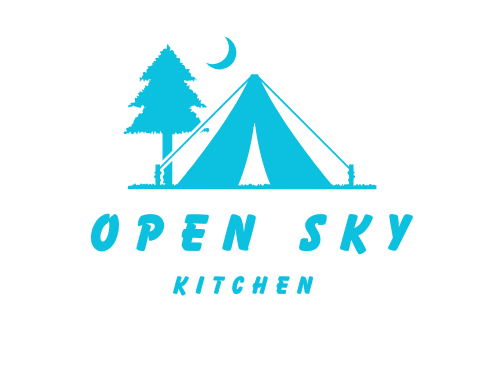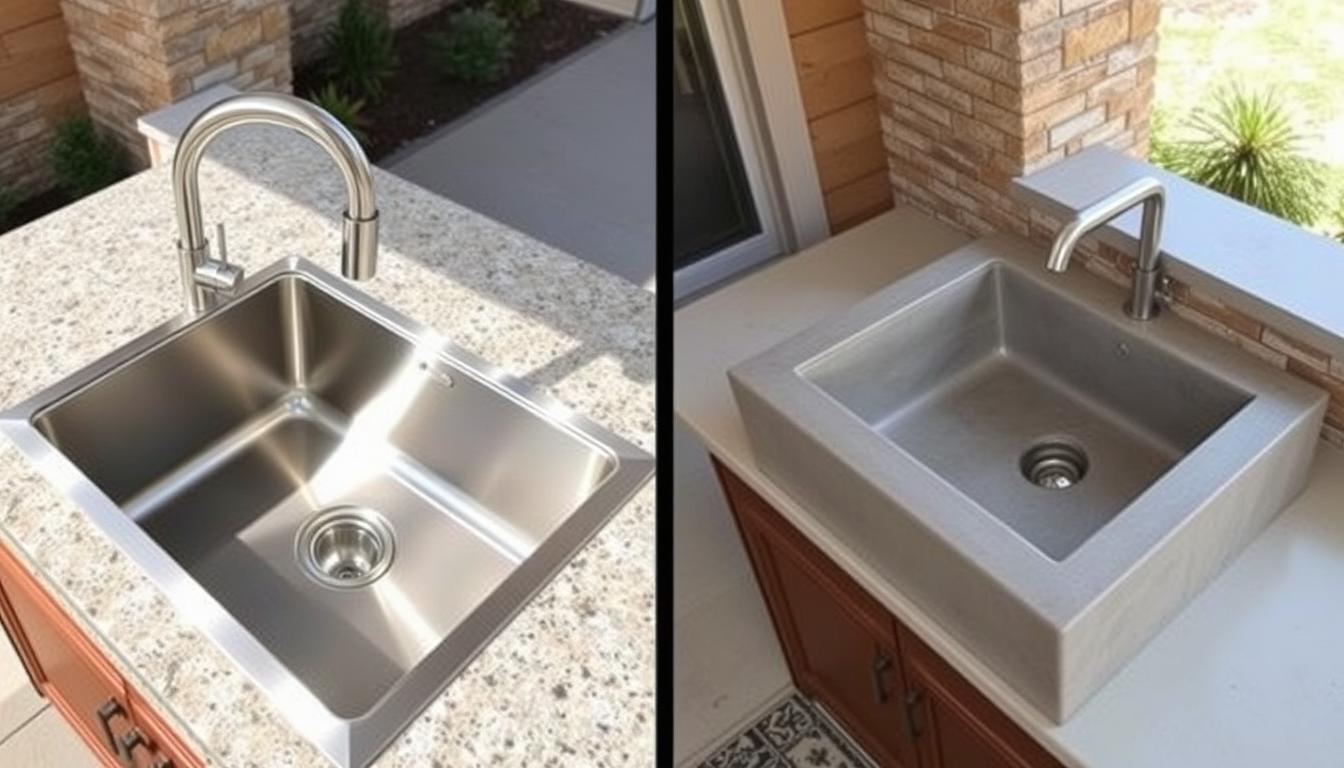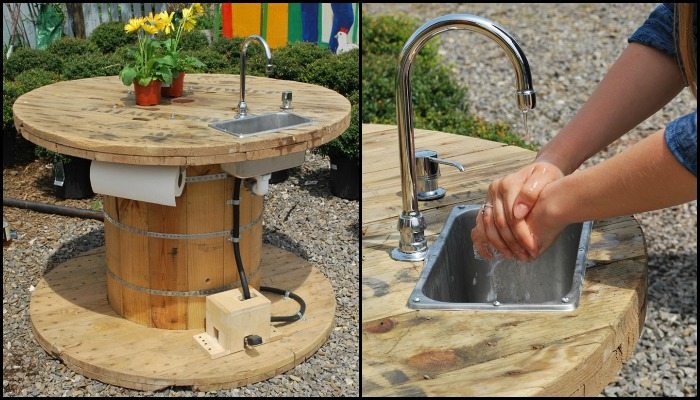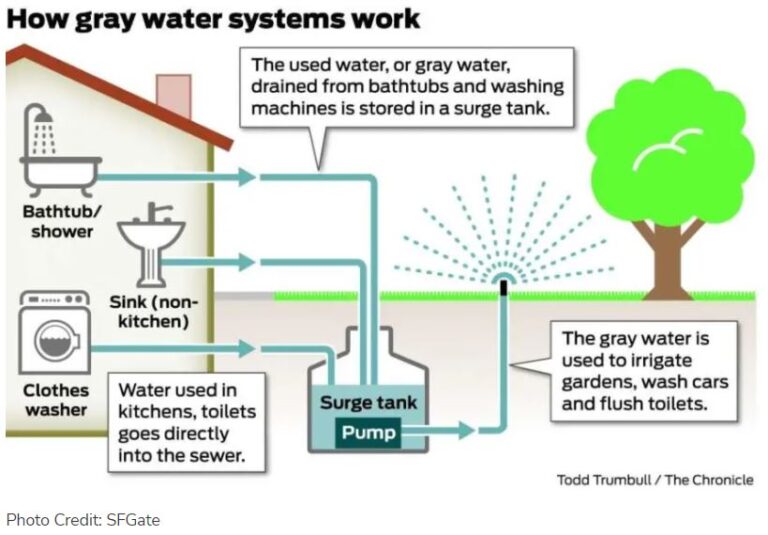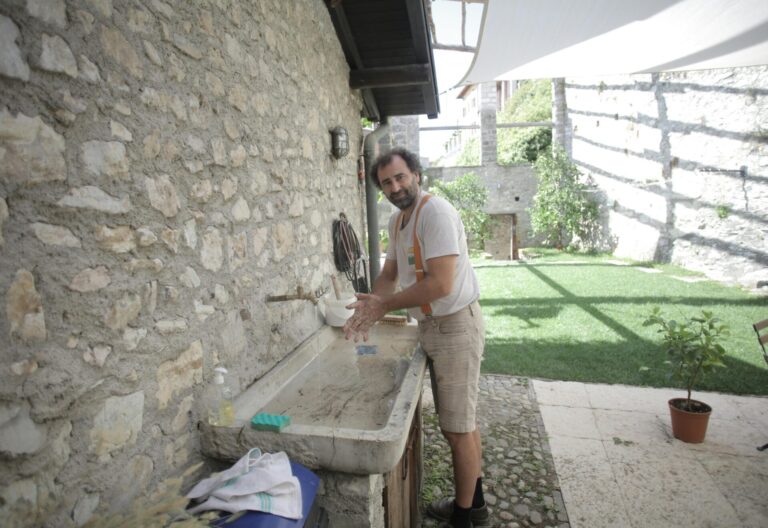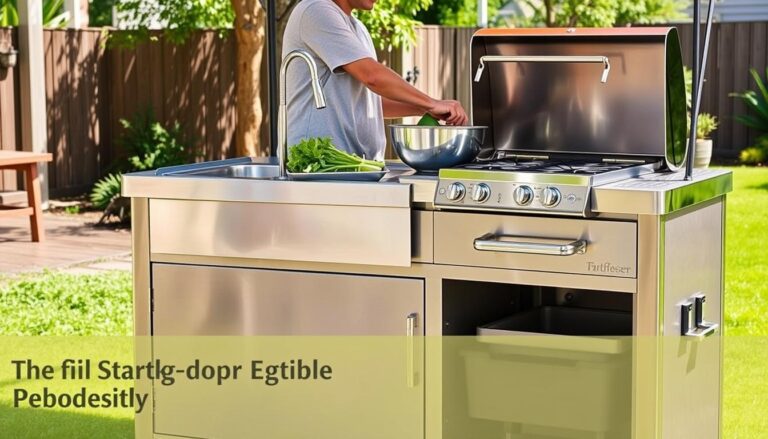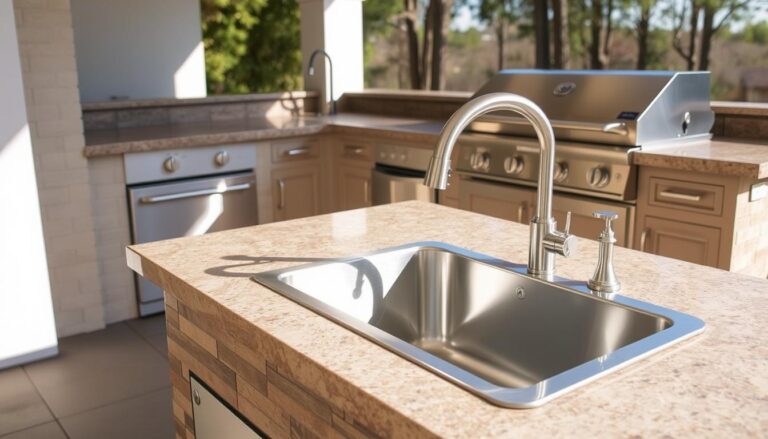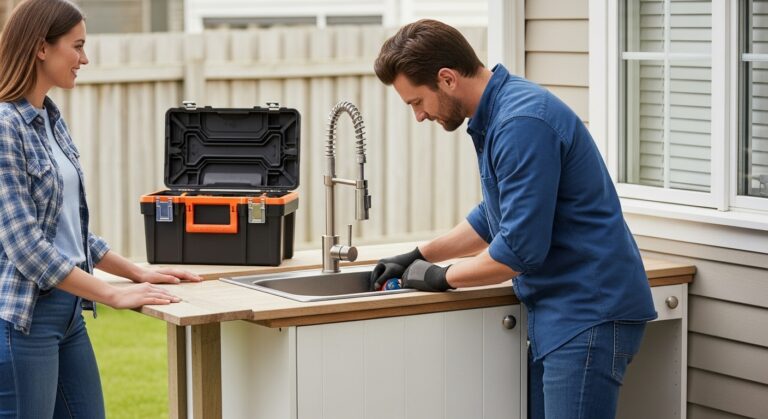Stainless Steel vs Concrete Outdoor Sinks: Which One is Better?
Choosing between stainless steel vs concrete outdoor sinks can be challenging when planning your outdoor kitchen. Both materials offer distinct advantages and potential drawbacks that impact durability, maintenance requirements, and overall aesthetics. Whether you’re designing a modern outdoor cooking space or a rustic garden washing station, the sink material you select will significantly influence both functionality and style.
This comprehensive comparison will help you understand the key differences between these popular outdoor sink materials, providing practical insights to guide your decision based on your specific needs, climate considerations, and design preferences.
Stainless Steel vs Concrete Outdoor Sinks: Quick Comparison
| Feature | Stainless Steel Sinks | Concrete Sinks |
| Durability | Highly resistant to rust, corrosion, and stains | Extremely durable but requires sealing to prevent cracks |
| Maintenance | Easy to clean with soap and water | Needs regular sealing and careful cleaning |
| Aesthetics | Modern, sleek appearance | Rustic, customizable, unique look |
| Cost | $200-$800 for quality options | $500-$2,000+ depending on customization |
| Weight | Lightweight, easier installation | Very heavy, requires strong support |
| Customization | Limited to standard sizes and shapes | Highly customizable in shape, color, and texture |
Stainless Steel Outdoor Sinks: Durability Meets Convenience
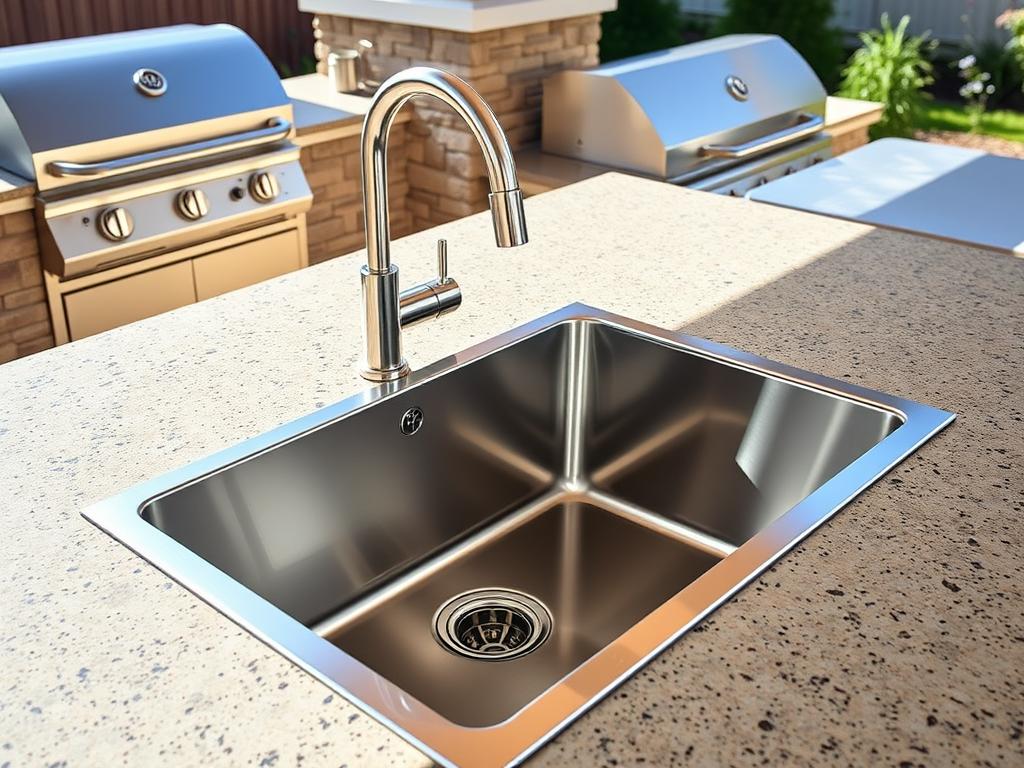
Stainless steel sinks are the most popular choice for outdoor kitchens, and for good reason. They combine strength, versatility, and elegance, making them suitable for various outdoor settings from contemporary to traditional designs.
Why Stainless Steel Sinks Are Popular for Outdoor Kitchens
Stainless steel consistently outperforms other materials in terms of durability and convenience. These sinks withstand the elements remarkably well while maintaining their sleek appearance with minimal effort. The enduring popularity of stainless steel outdoor sinks stems from their practical benefits and timeless appeal.
Advantages of Stainless Steel Outdoor Sinks
- Superior Durability: Resistant to rust, corrosion, and stains, even when exposed to harsh weather conditions.
- Low Maintenance: Simple cleaning with soap and water is usually sufficient to keep them looking pristine.
- Temperature Resistance: Can withstand extreme temperature changes without cracking or warping.
- Lightweight Design: Easier to install and doesn’t require reinforced cabinetry or countertops.
- Affordability: Generally more cost-effective than concrete and other premium materials.
- Hygienic Surface: Non-porous surface prevents bacteria growth and is easy to sanitize.
Disadvantages of Stainless Steel Outdoor Sinks
- Shows Water Spots: Can display water spots and fingerprints that detract from its polished look.
- Limited Customization: Typically available in standard sizes and shapes with fewer custom options.
- Noise Level: Can be noisy when water or items hit the surface (though this can be mitigated with undercoating).
- Uniform Appearance: Lacks the unique character and customization potential of concrete.
- Potential for Scratching: Can develop scratches over time, especially with abrasive cleaners.
Best Applications for Stainless Steel Outdoor Sinks
Stainless steel sinks are ideal for homeowners who prioritize durability and low maintenance in their outdoor kitchen. They’re particularly well-suited for:
- High-traffic outdoor kitchens with frequent use
- Areas with extreme weather conditions
- Modern or contemporary outdoor design schemes
- Situations where budget considerations are important
- Households seeking easy cleaning and maintenance
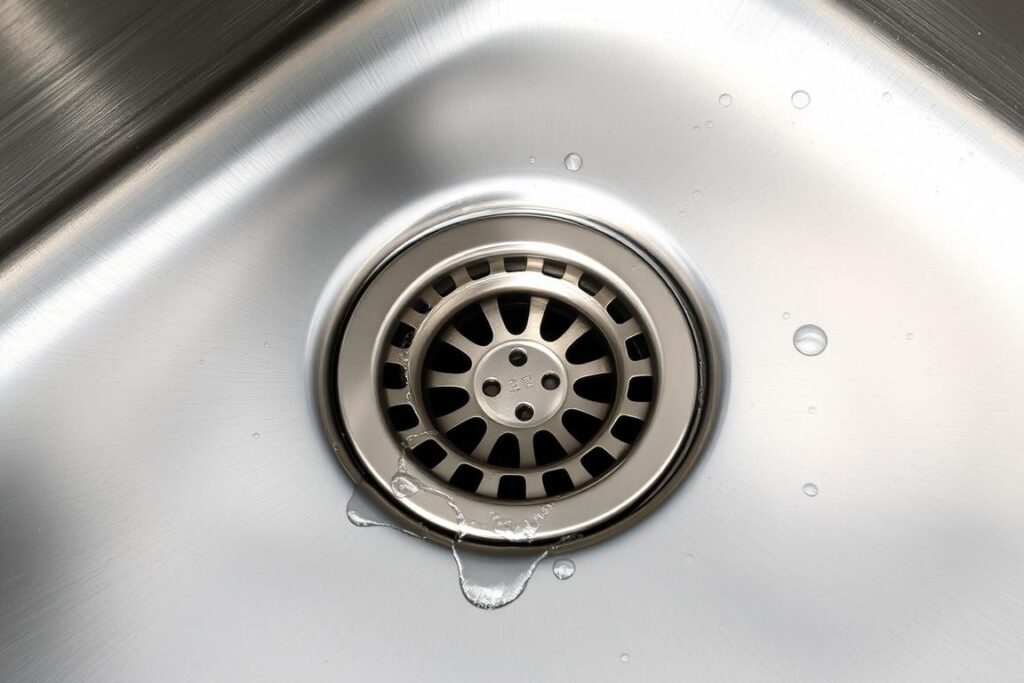
Maintenance Tips for Stainless Steel Outdoor Sinks
To keep your stainless steel sink looking its best in an outdoor environment:
- Wipe down the sink after each use to prevent water spots
- Clean regularly with mild dish soap and water
- Avoid abrasive cleaners that can scratch the surface
- Apply a stainless steel polish occasionally to maintain shine
- For stubborn stains, use a paste of baking soda and water
- In coastal areas, rinse more frequently to prevent salt air corrosion
Not Sure Which Sink Material Is Right For You?
Download our free Outdoor Sink Material Guide with detailed specifications, maintenance calendars, and installation tips for both stainless steel and concrete sinks.
Concrete Outdoor Sinks: Customization and Character
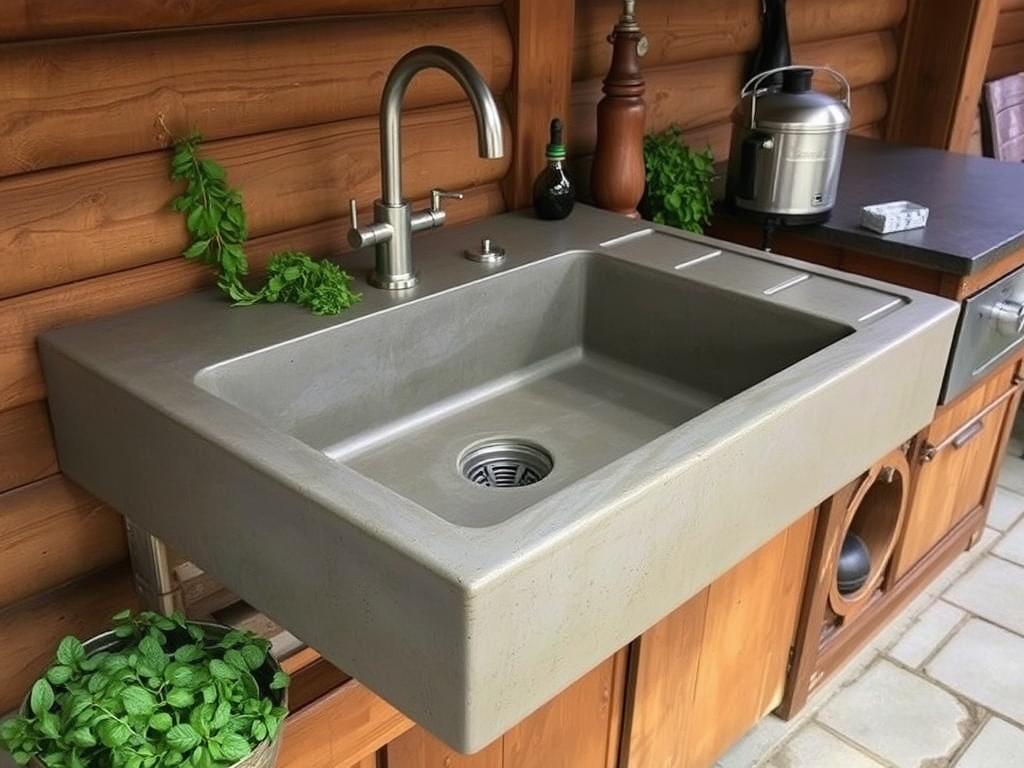
Concrete sinks are rapidly gaining popularity for modern outdoor kitchens, prized for their unparalleled customization options and distinctive character. A concrete sink is more than just a functional element—it’s a statement piece that can define the personality of your outdoor space.
The Appeal of Concrete Sinks for Outdoor Spaces
Concrete sinks offer extraordinary design flexibility. Unlike mass-produced options, concrete can be molded into virtually any shape, size, or configuration. This versatility allows homeowners to create truly bespoke outdoor kitchen elements that perfectly complement their specific aesthetic vision and functional requirements.
Advantages of Concrete Outdoor Sinks
- Unlimited Customization: Can be crafted in any shape, size, color, or texture to match your specific design vision.
- Unique Appearance: Each sink is one-of-a-kind with distinctive character and artisanal quality.
- Extreme Durability: When properly sealed, concrete sinks can last for decades even in outdoor environments.
- Design Continuity: Can be seamlessly integrated with concrete countertops for a cohesive look.
- Heat Resistance: Excellent thermal properties allow concrete to withstand hot pots and pans.
- Aging Character: Develops a natural patina over time that many homeowners find appealing.
Disadvantages of Concrete Outdoor Sinks
- Maintenance Requirements: Needs regular sealing to prevent stains, cracks, and water absorption.
- Significant Weight: Extremely heavy, requiring substantial structural support in cabinetry.
- Higher Cost: Custom concrete work typically costs more than standard stainless steel options.
- Potential for Cracking: Without proper reinforcement and sealing, concrete can develop cracks over time.
- Installation Complexity: Often requires professional installation due to weight and sealing requirements.
- Porosity Concerns: If improperly sealed, can absorb liquids and harbor bacteria.
Best Applications for Concrete Outdoor Sinks
Concrete sinks are particularly well-suited for:
- Custom and unique outdoor kitchen designs
- Rustic, farmhouse, or industrial aesthetic preferences
- Situations where a one-of-a-kind statement piece is desired
- Integrated sink-countertop designs with seamless transitions
- Homeowners willing to perform regular maintenance
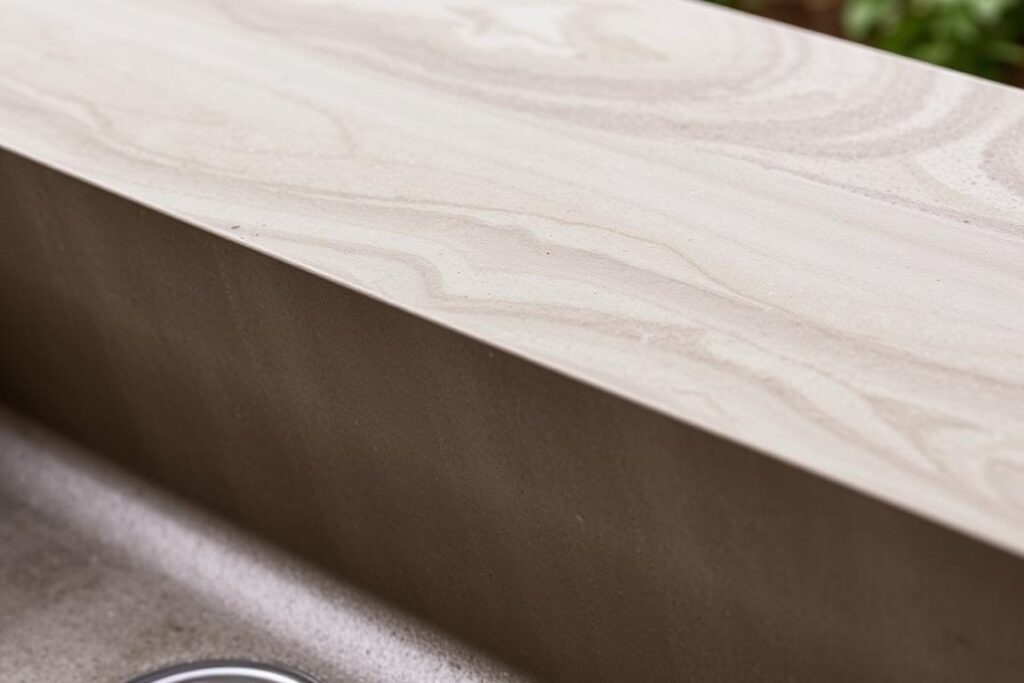
Maintenance Tips for Concrete Outdoor Sinks
To maintain the beauty and functionality of a concrete outdoor sink:
- Apply a high-quality concrete sealer every 6-12 months
- Clean with pH-neutral cleaners to avoid damaging the sealer
- Wipe up acidic substances (lemon juice, vinegar) immediately
- Use cutting boards and avoid direct contact with hot pots
- Inspect regularly for small cracks and address them promptly
- Consider applying a food-safe wax for additional protection
Installation Considerations: What You Need to Know
Stainless Steel Sink Installation
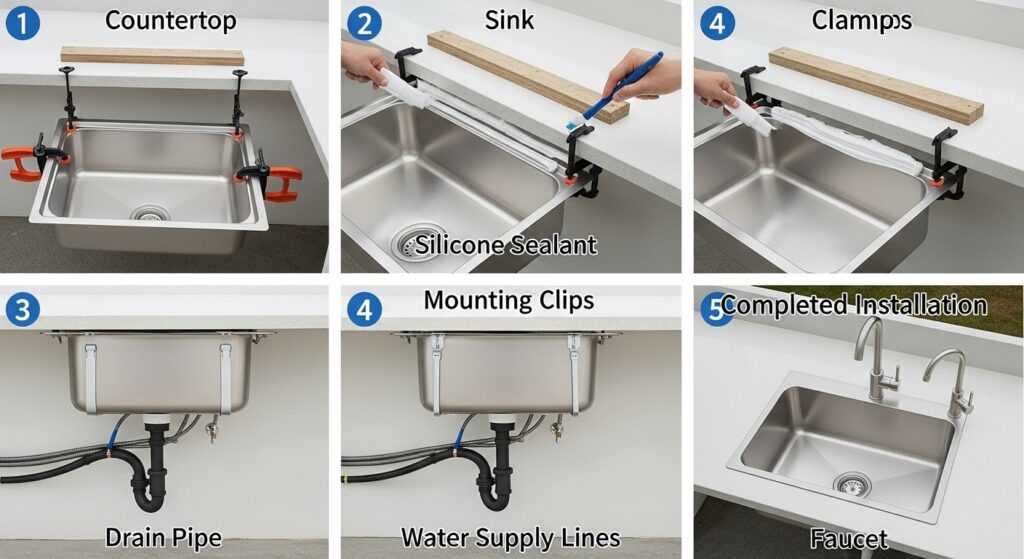
- Weight Considerations: Relatively lightweight, requiring standard cabinet support
- Installation Options: Available in drop-in (easiest) or undermount styles
- DIY Potential: Moderately DIY-friendly with basic plumbing knowledge
- Support Requirements: Standard cabinet construction is typically sufficient
- Weatherproofing: Naturally weather-resistant, minimal special considerations
Concrete Sink Installation
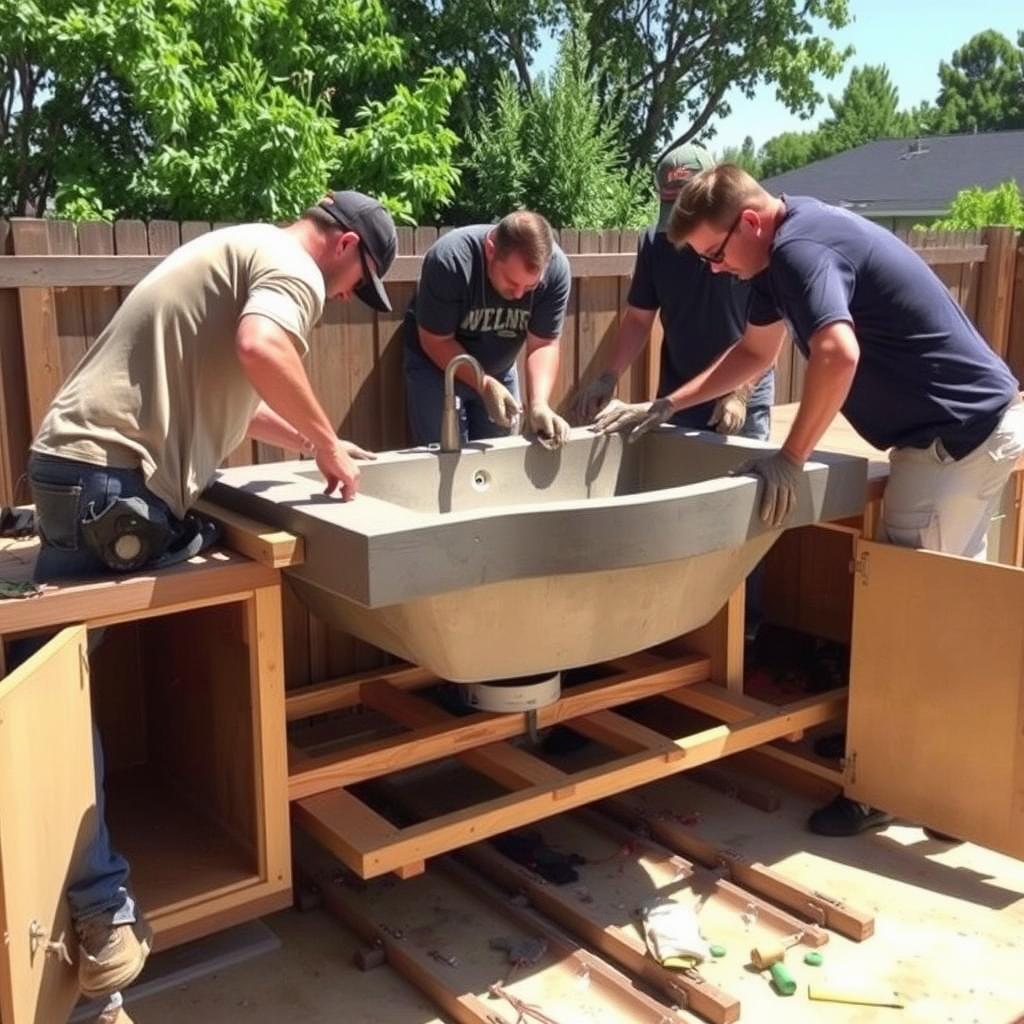
- Weight Considerations: Extremely heavy, requiring reinforced support structures
- Installation Options: Often custom-built in place or carefully installed as a pre-cast unit
- DIY Potential: Generally requires professional installation
- Support Requirements: Needs substantial reinforcement in cabinetry and countertops
- Weatherproofing: Requires proper sealing to prevent moisture damage
Climate Considerations for Outdoor Sinks
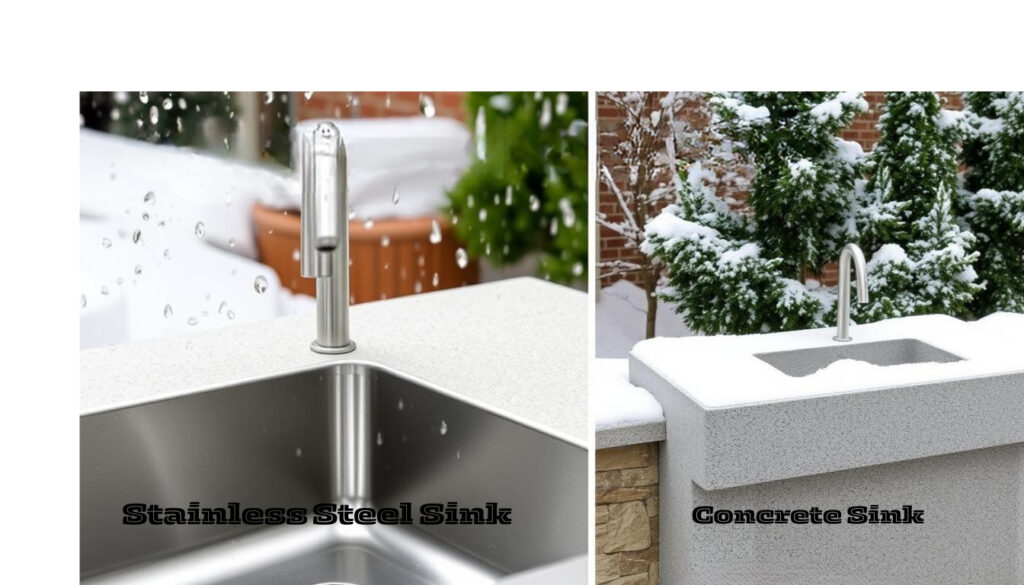
Coastal Environments
- Stainless Steel: Choose marine-grade (316) stainless steel to resist salt air corrosion
- Concrete: Requires more frequent sealing to prevent salt penetration and deterioration
Freezing Climates
- Stainless Steel: Excellent freeze-thaw resistance, but plumbing must be winterized
- Concrete: More susceptible to cracking from freeze-thaw cycles without proper sealing
Hot, Sunny Environments
- Stainless Steel: Can become very hot to touch; consider location to avoid direct sun
- Concrete: Better heat absorption properties but may fade with prolonged UV exposure
Humid Regions
- Stainless Steel: Naturally resistant to humidity issues
- Concrete: May develop mold or mildew if the sealer fails; requires vigilant maintenance
Cost Comparison: Budget Considerations
Initial Purchase and Installation Costs
| Cost Factor | Stainless Steel Sinks | Concrete Sinks |
| Basic Sink Unit | $200-$500 | $500-$1,200 |
| Premium/Custom Options | $500-$800 | $1,200-$2,500+ |
| Installation Labor | $200-$400 | $400-$800 |
| Additional Support Requirements | Minimal ($0-$100) | Substantial ($200-$500) |
| Total Typical Cost Range | $400-$1,300 | $1,100-$3,800+ |
Long-Term Maintenance Costs
Stainless Steel Maintenance Costs
- Cleaning supplies: $20-$50 annually
- Occasional polish: $10-$20 annually
- Potential replacement parts (faucet, drain): $50-$150 every 5-10 years
- Minimal additional long-term costs
Concrete Maintenance Costs
- Sealer: $30-$100 every 6-12 months
- Specialized cleaning products: $30-$60 annually
- Potential crack repairs: $100-$300 as needed
- Professional resealing service (optional): $200-$400 annually
Budget Tip: When comparing costs, remember to factor in both initial purchase price and long-term maintenance expenses. While stainless steel typically has a lower upfront cost, concrete may offer more value if you’re seeking a truly custom, one-of-a-kind design element for your outdoor kitchen.
Design Considerations: Matching Your Outdoor Aesthetic
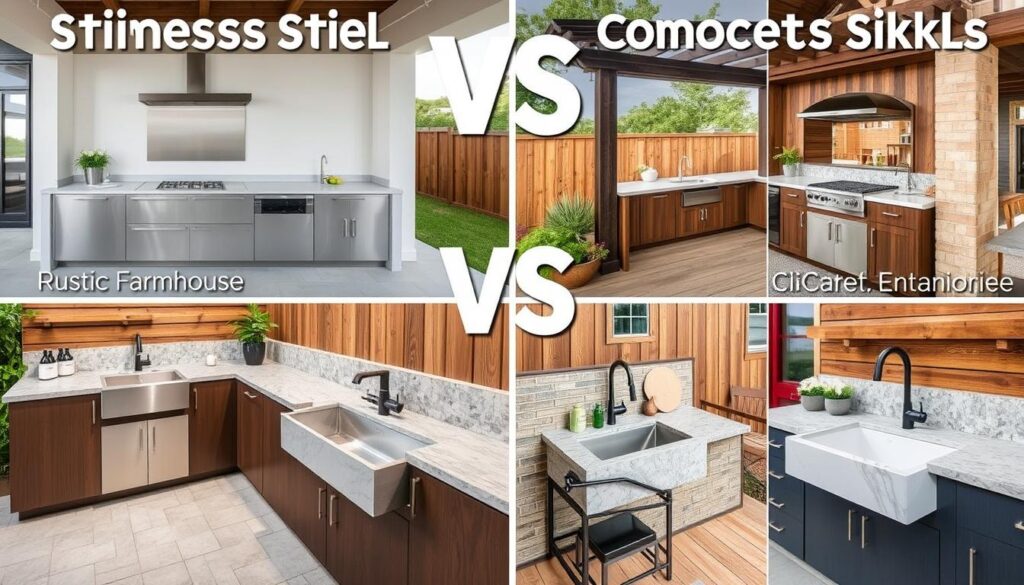
Complementary Design Styles
Stainless Steel Complements:
- Modern/Contemporary: Clean lines and reflective surfaces pair perfectly with minimalist designs
- Industrial: Raw metal aesthetic works well with exposed brick and metal accents
- Transitional: Versatile enough to bridge traditional and contemporary elements
- Coastal: Corrosion-resistant properties make it ideal for beachside properties
Concrete Complements:
- Rustic/Farmhouse: Earthy texture adds warmth to country-inspired spaces
- Industrial: Raw, unfinished look pairs well with reclaimed wood and metal
- Mediterranean: Can be colored and textured to match terracotta and natural stone
- Eco-Modern: Sustainable material choice for environmentally conscious designs
Integrating With Outdoor Kitchen Materials
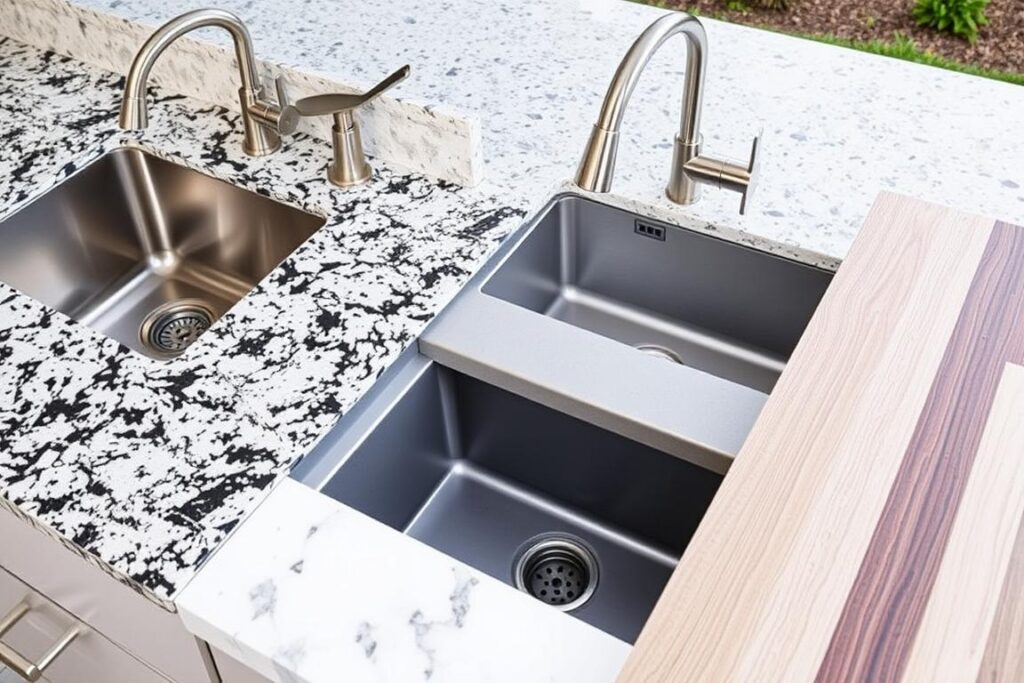
Stainless Steel Pairings:
- Granite countertops: Creates a high-end, contemporary look
- Tile surrounds: Provides contrast and visual interest
- Wood cabinetry: Offers warm/cool material contrast
- Other stainless appliances: Creates cohesive, professional appearance
Concrete Pairings:
- Concrete countertops: Creates seamless, integrated look
- Natural stone: Complements the earthy, organic qualities
- Reclaimed wood: Enhances rustic, artisanal aesthetic
- Brick surrounds: Creates textural harmony in traditional spaces
Real-World Applications: Best Uses for Each Material
Ideal Scenarios for Stainless Steel Outdoor Sinks
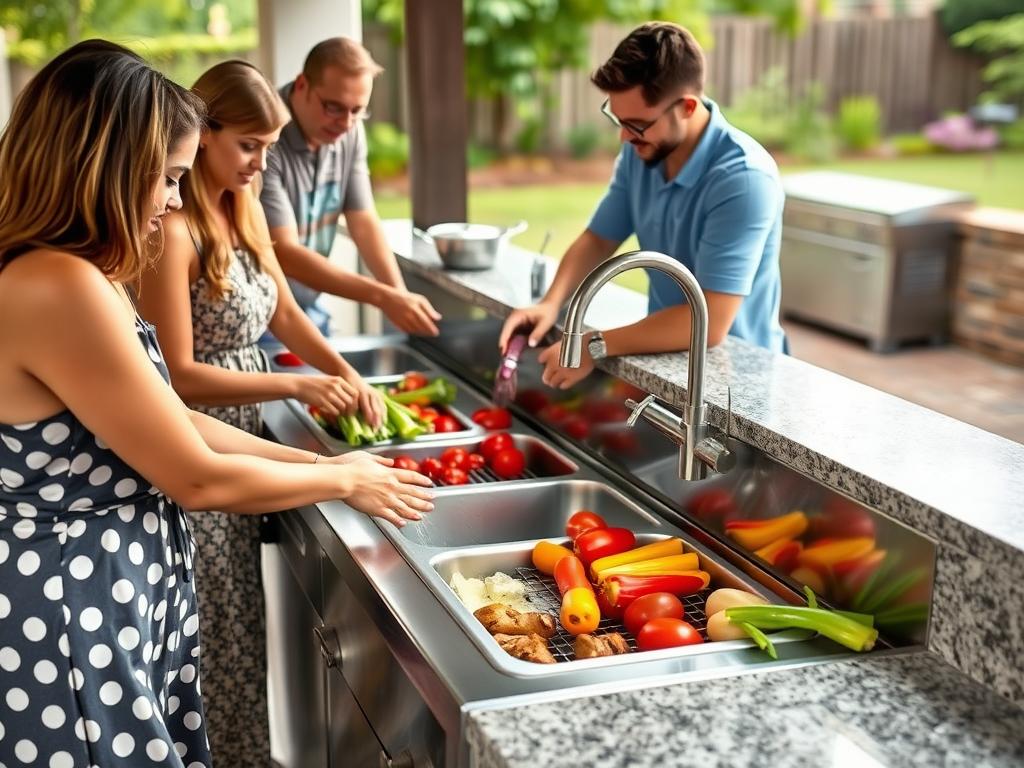
- High-Traffic Family Areas: Durable enough to withstand frequent use by family members of all ages
- Coastal Properties: Marine-grade stainless resists salt air corrosion
- Rental Properties: Low maintenance requirements are ideal for properties with changing tenants
- Commercial Outdoor Kitchens: Meets health code requirements for commercial food preparation
- Modern Architectural Designs: Clean lines complement contemporary structures
Ideal Scenarios for Concrete Outdoor Sinks
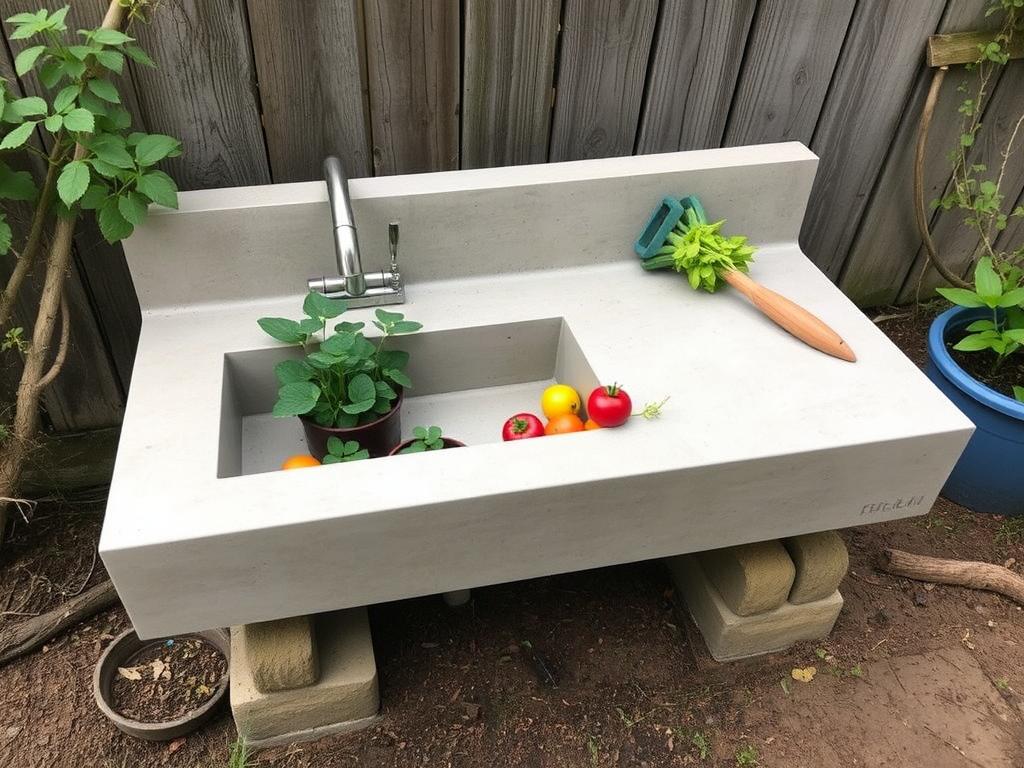
- Custom Home Builds: When a truly unique, personalized element is desired
- Artistic Outdoor Spaces: Where the sink serves as both functional element and art piece
- Garden Washing Stations: Earthy aesthetic blends naturally with garden environments
- Outdoor Bars: Can be molded with integrated features like bottle holders or ice wells
- Rustic Retreats: Natural appearance complements cabin and cottage aesthetics
Expert Recommendations: Making Your Final Decision

Questions to Ask Yourself Before Choosing
- What is your maintenance tolerance? If you prefer minimal upkeep, stainless steel may be better.
- What is your primary design aesthetic? Modern minimalist or rustic farmhouse?
- What is your climate? Consider freeze-thaw cycles, humidity, and salt exposure.
- What is your budget? Both initial and long-term maintenance costs.
- How important is customization? Do you need a standard size or a unique configuration?
- How frequently will the sink be used? Daily family use or occasional entertaining?
- What other materials are in your outdoor kitchen? Consider visual cohesion.
“The best outdoor sink material isn’t about what’s trending—it’s about what works for your specific lifestyle, climate, and design preferences. Stainless steel offers practicality and durability, while concrete provides unmatched customization and character. Consider how you’ll actually use the space before making your decision.”
Conclusion:
Choosing Between Stainless Steel vs Concrete Outdoor Sinks
When deciding between stainless steel vs concrete outdoor sinks, there’s no universally “better” option—the right choice depends entirely on your specific needs, preferences, and circumstances.
Choose Stainless Steel If:
- You prioritize low maintenance and durability
- Your outdoor kitchen has a modern or contemporary design
- You’re working with a moderate budget
- You live in a harsh climate (coastal, freezing, etc.)
- Your outdoor kitchen sees frequent, heavy use
Choose Concrete If:
- You desire a truly custom, one-of-a-kind sink
- Your outdoor space has a rustic, farmhouse, or artisanal aesthetic
- You’re willing to perform regular maintenance
- You want a sink that serves as both a functional element and a design feature
- You have adequate structural support for a heavier installation
Whichever material you choose, proper installation and maintenance are key to ensuring your outdoor sink provides years of functionality and enjoyment. Consider consulting with a professional outdoor kitchen designer who can help you evaluate all factors specific to your situation and guide you toward the best solution for your outdoor living space.
